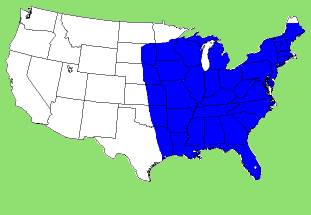Descriptive Qualities:
Range
Imperial's range is
Map of this moth's Area:

Eggs and Larva
Depending on the particular size of the moth, female Imperial moths have approximately eggs.
Scenting and Mating
Female Imperials usually put their scent out from . The males may come in at any time during this period. It is easiest to put the female in a metal cage with holes big enough that they can mate through it (about a half inch or 3/4 inch hole should do nicely) but small enough that the female cannot escape. That is the best way to do it if you don't have the luxury of staying up all night to watch them. I usually stay up and wait for the males to come in, and then put them with the female. This way is the only real way to tell how many came in.
Cocoons
Imperial larva do not make cocoons. The larva crawl down from their host plant, burrow into the ground, and pupate. Imperials have only brood, in all of their area.
Personal Markings or Characteristics
The Imperial moth is yellow with brown/red sometimes even purple blotches on their wings.
Caring For Imperials, In All Stages:
Here are some notes that may be helpful when trying to raise Imperial larva, especially if it's your first time raising them.Caring for the eggs
To care for Imperial eggs, just put them in a small container. It is best to be small, because the larva like to crawl a lot when they first hatch, and if you put them in a bigger container, they will crawl away from the food you put in with them, and might not be able to get back. That's a lot of area for such a small caterpillar.
Food Plants
Raising Imperial Larva (Inside)
Unknown by me, as yet.
Raising Imperial Larva (Outside)
Unknown by me, as yet.
Caring for the pupa
To care for Imperial pupa, the larva, when ready to pupate, can be placed in a container of dirt and be allowed to burrow into it and pupate, or the larva can just be kept in it's container and should pupate at the bottom, whether dirt or not. Then you should put the pupa in a safe place. Most likely in dirt, but it doesn't have to be.
Click here to return to the Index
Comments and suggestions are welcome, send them to me at: [email protected]